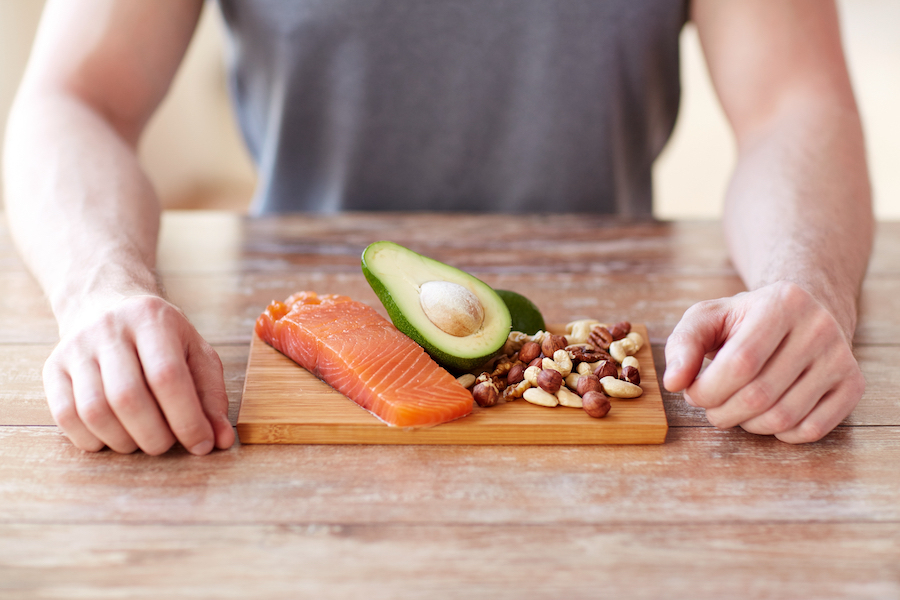Protein: Is It Bad for Your Gut?

The nutrition world can be a contentious, polarized place filled with passionate believers and practitioners who have a difficult time accepting anything outside “their” diet. In that regard, nutrition can feel like a religion, in that there are zealots who believe in only one nutritional recommendation.
That atmosphere surrounds the subject of protein. Some people believe protein is necessary for health; others believe it’s the root cause of all diseases. The anti-protein faction believes protein rots in your gut.
The technical term is putrefaction. Putrefaction comes from the root word putrefacere: “to make rotten.” The root word gives it a negative connotation. Technically, putrefaction means ”the anaerobic breakdown of undigested protein in the colon by microbiota.”
However, researchers such as Windey et al. refer to the putrefaction process as protein fermentation. [1] The process of fermentation is a normal physiological function in the digestive tract. However, fermentation in the gut is not so black and white. There’s fermentation of protein as well as fiber. Let’s discuss the former first.
In the context of protein fermentation, many compounds are produced, including ammonia, phenols, and indoles. These compounds are considered to contribute to the development of colon cancer. [2] Anti-protein advocates presume that ammonia, phenols, and indoles are harmful to the body and the only factor causing colon cancer.
On the contrary, small amounts of these compounds are not considered harmful. [3] With regard to ammonia, it’s a natural by-product of protein fermentation. In fact, ammonia has an important role in nitrogen recycling. [4]
The Benefits of Protein and Fiber in the Gut
The argument that protein causes colon cancer or harm to the digestive tract is a false dichotomy. The increase in some of the volatile compounds mentioned earlier may be an issue if a person only ate meat and nothing else. The reality is most people eat meat combined with other foods.
Combining protein with vegetables and fruit counteracts the possible detrimental effects of the compounds of protein fermentation.
The combination of protein and other foods changes everything. When a person consumes protein with a source of fiber (i.e. vegetables and fruit) and/or resistant starch, the combination of compounds diminishes any negative effects of protein. [5,6]
This is precisely why a Paleo Diet is so effective, because it combines lean protein sources with vegetables and fruit. The studies that suggest byproducts of protein fermentation contribute to the development of colon cancer are correlative at best. It doesn’t prove protein causes colon cancer. As with any disease, there are multiple factors involved. Other factors such as smoking, alcohol, and insulin resistance contribute to the risk of colon cancer. [1]
Now let’s consider fiber fermentation. Vegetables and fruit are the main sources of fiber. Fermentation of fibers by healthy bacteria in your gut produce short chain fatty acids (SCFAs). SCFAs have been shown to have anti-microbial effects, protect the gut lining (i.e. prevent leaky gut), and be anti-inflammatory. [7,8,9]
Vegans use the benefits of SCFAs to argue in support of their recommendation for a plant-based diet. They tout the benefits of SCFAs from vegetables and fruit yet condemn the consumption of protein. What many fail to realize is that SCFAs can also be produced from protein via the process of deamination of excess amino acids. [10]
So, protein fermentation can be beneficial. As mentioned earlier, combining protein with vegetables and fruit counteracts the possible detrimental effects of the compounds of protein fermentation. Simultaneously, it increases SCFA levels that protect the gut.
The Flaws of Protein Studies
We must also look at the type of research study performed when assessing the effects of protein fermentation. A study by MacFarlane et al. showed a significant increase in ammonia and volatile fatty acids. [11] However, this study was conducted in vitro, in incubated casein and bovine serum albumin over a 96-hour period. In vitro studies are conducted in a test tube, not in a human being.
The digestive system is a complex and intricate system from mouth to anus, with extensive changes in pH, acids, and enzymes. This in vitro study doesn’t factor in gut transit time. Remember the last time you had red beets? You might have looked into the toilet and thought you had pooped out blood! However, it’s the beets that gave your stool the bloody color.
It’s important to realize normal gut transit time is about 12 to 24 hours. [12] So, if you eat red beets at noon for lunch, you most likely will see them again the next morning when you go to the bathroom. According to the study above, a 96-hour incubation produced volatile compounds—but that’s like someone not pooping for four days!
If you haven’t had a bowel movement for four days, the production of volatile fatty acids, as well as other toxic compounds, will increase. Simply putting protein in a test tube is elementary at best. It’s not a fair representation of a normal functioning digestive system.
It is also important to consider the type of protein that is administered in any given study. A human study by Geypens et al. had subjects increase protein intake from 15.4% to 23.8% for one week. [13] Results showed an increase in fecal ammonia, fecal valeric acid, and urinary p-cresol. While on the surface these results may seem concerning, we must consider the type of protein used—a supplement called Fortimel, the nutritional breakdown of which revealed a significant quantity of both lactose and casein. Furthermore, the subjects consumed an amount equivalent to approximately a pint of milk per day.
The milk sugar, lactose, is just one component that complicates things. Normally, lactose is broken down to galactose and glucose for the body to absorb, provided the gastrointestinal tract can make lactase. Lactase is the enzyme produced by the gut that breaks down lactose.
About 65 percent of the population do not have the genes to make lactase. [14] The consequence is that the gut microbiota ferments lactose. This leads to symptoms of gas, bloating, diarrhea and/or abdominal cramping. Internally, the fermentation process of lactose produces volatile fatty acids and gases such as hydrogen, methane and carbon dioxide. [15]
So, in this study, it is very likely that the carbohydrate, not the protein, caused the volatile fatty acids and gases to be produced.
Lactose is not the only issue to consider. In the context of protein, dairy consists predominately of casein. It’s considered one of the most allergenic proteins a human can consume. [16] Based on this study, individuals might assume all proteins rot in the gut, when in fact all proteins are not created equal.
Red Meat Is Not a Villain
This skewed logic continues with animal protein, especially red meat, which has become like a villain in a movie. Every time something goes wrong in the body, red meat gets the blame. But it’s a more complicated situation. Many of the studies blaming red meat for a disease are correlative studies. So, over a lengthy period of time, researchers will look at the consumption of red meat and look for associations with disease.
Most studies looking at red meat make no distinction between grass-fed, grain-fed, or processed red meat.
In particular, a study from the Journal of the American Medical Association concluded “that prolonged high consumption of red and processed meat may increase the risk of cancer in the distal portion of the large intestine.” [17]
There are several issues to consider with this study. The first is the flaw of a modified Block Food Frequency Questionnaire (FFQ). This is a questionnaire based upon questions such as “How often did you eat beef, pork, or lamb as a main dish and how many ounces?” Subjects were asked to report their eating habits regarding protein over the last year.
Most people can’t remember what they ate yesterday, let alone a year ago. Also, the likelihood of a person knowing the amount, in ounces, of protein is zero to none. Consequently, the accuracy of the amount of protein consumed comes into question.
In addition, Block FFQs are tailored to certain food types that researchers are investigating. A block FFQ typically does not take into consideration the other foods consumed with processed red meat. For instance, sausage, pepperoni, and salami are eaten on things like pizza, as well as sandwiches eaten with chips and French fries. These additional foods are junk foods full of trans fatty acids and processed ingredients that can wreak havoc on the gut.
Another issue with this type of study is the grouping of red meat and processed red meat together. It’s like comparing apples to oranges. They aren’t the same protein. The researchers considered processed red meat as: bacon, sausage, hot dogs, ham, bologna, salami, and lunchmeat.
The first difference between red and processed meat is the sodium and preservative content. Processed red meats have been suggested to have up to four times more sodium and approximately 50 percent more preservatives than red meat. [18] Preservatives such as N-nitroso compounds may have an impact on the genesis of colorectal cancer. [19]
Besides sodium and preservatives, there is a significant difference between grass-fed and grain-fed red meat. We’ve all heard the phrase, “You are what you eat.” The same holds true in animals. One of the biggest differences between grass-fed and grain-fed red meat is the fatty acid content. A healthy ratio of omega-6 to omega-3 acids sits at around 2:1. On average, the Standard American Diet radically skews the omega-6 to omega-3 ratio, which can be as high as 30:1. This may have a significant impact on rates of inflammation and disease. [20]
Grass-fed meat has an ideal ratio of omega-6 to omega-3 fatty acids. A review of fatty acid analysis has shown an average of 1.53 in grass-fed red meat versus 7.65 in grain-fed red meat. [21] Although the fatty acids have nothing to do with protein intake, they have everything to do with preventing inflammation and disease. Most studies looking at red meat make no distinction between grass-fed and grain-fed red meat.
Gut Health Is Critical
When it comes to preventing disease and inflammation, the gut microbiome can’t be ignored. A PubMed search on the subject produces 85,000 results. A Google search returns 17 million hits.
Every day new research is emerging about the gut microbiome and health. That microbiome may play a role in many diseases such as obesity, diabetes, liver disease, and neurodegenerative diseases. [22] Everyone’s gut microbiome is different. There are so many influences on the gut microbiome such as age, geographical location, host genetics, social context, and diet. [23]
The health of the gut microbiome is critical to preventing disease in the body. In the context of diet, there is evidence to suggest that a high protein intake increases gut microbiome diversity. [24]
Combining animal and plant foods is one way to ensure a healthy gut microbiome.
A recent article in Nutrients provided subjects with a calorie restricted diet (500 calorie reduction) over six weeks. A high protein group (HPG) was given 30 percent protein while the normal protein group (NPG) was given 15 percent protein.
Most people would likely assume the NPG would have had a larger increase in gut diversity versus the HPG due to the higher intake of grains, starches, and fruit. On the contrary, the HPG consumed fewer starches, grains, and fruit in order to achieve the higher protein intake yet the gut microbiome diversity increased.
To achieve the 30 percent protein, the HPG was given a pea protein-based supplement. It’s important to note the protein intake for the HPG was a mix of proteins. The researchers stated: “In our study, we prescribed a combination of protein from lean meats and plant sources, including a protein supplement derived from peas, to provide a diversity of protein sources.”
Varying sources of protein is a very important concept. Eating animal and plant protein sources provides a wide variety of amino acids and fatty acids for health. Combining animal and plant foods is one way to ensure a healthy gut microbiome.
And at the end of the day, a healthy gut microbiome is essential for avoiding anything that rots in your gut.
References
- Windey K, De Preter V, Verbeke K. Relevance of protein fermentation to gut health. Mol Nutr Food Res. 2012;56: 184-196.
- Cummings JH, Hill MJ, Pearson JR, Wiggins HS. Changes in fecal composition and colonic function due to cereal fiber. Am J Clin Nutr. 1976;29: 1468-1472.
- Dallas DC, Sancturay MR, Qu Y, Khajavi SH, Van Zandt AE, Dyandra M, Frese SA, Barile D, German JB. Personalizing Protein Nourishment. Crit Rev Food Sci Nutr. 2017 Oct 13;57(15):3313-3331.
- Bergen WG, Wu G. Intestinal nitrogen recycling and Utilization in Health and Disease. J Nutr. 2009 May;139(5):821-5.
- Birkett A, Muir J, Phillips J, Jones G et al. Resistant starch lowers fecal concentrations of ammonia and phenols in humans. Am J Clin Nutr. 1996;63:766-772.
- Clark A, Mach N. Exercise-induced stress behavior, gut- microbiota-brain axis and diet: a systematic review for athletes. J Int Soc of Sports Nutr;2016:13:43.
- Cherrington CA, Hinton M, Pearson GR, Chopra I. Short-chain organic acids at ph 5.0 kill Escherichia coli and Salmonella spp. without causing membrane perturbation. J. Appl. Bacteriol. 1991;70: 161–165.
- Feng Y, Wang Y, Wang P, Huang Y, Wang F. Short-Chain Fatty Acids Manifest Stimulative and Protective Effects on Intestinal Barrier Function Through the Inhibition of NLRP3 Inflammasome and Autophagy. Cell. Physiol. Biochem. 2018;49:190–205.
- Levy M, Thaiss CA, Elinav E. Metabolites: Messengers between the microbiota and the immune system. Genes Dev. 2016;30:1589–1597.
- Blachier F, Mariotti F, Juneau JF, Tome D. Effects of amino acid-derived luminal metabolites on the colonic epithelium and physiopathological consequences. Amino Acids.2007;33:547-562.
- Macfarlane GT, Cummings JH, Allison C. Protein degradation by human intestinal bacteria.J Gen Microbiol. 1986;132:1647-56.
- Lipski, L. 1996. Digestive Wellness (2nd Edition). Lincolnwood, Ilinois:Keats Publishing..
- Geypens B, Claus D, Evenepoel P, Hiele M, Maes B, Peeters M, Rutgeerts P, Ghoos Y. Influence of dietary protein supplements on the formation of bacterial metabolites in the colon. Gut. 1997 Jul;41(1):70-6.
- Ingram CJ, Mulcare CA, Itan Y, Thomas MG, Swallow DM. Lactose digestion and the evolutionary genetics of lactase persistence. Hum Genet. 2009 Jan;124(6):579-91.
- Di Costanzo M, Berni Canani R. Lactose Intolerance: Common Misunderstandings. Ann Nutr Metab. 2018;73(suppl4):30-37.
- Katz Y, Goldberg MR, Zadik-Mnuhin G, Leshno M, Heyman E. Cross-sensitization between milk proteins: Reactivity to a “kosher” epitope? Isr Med Assoc J. 2008;10: 85–88.
- Chao A, Thun MJ, Connell CJ, McCullough ML, Jacobs EJ, Flanders WD, Rodriguez C, Sinha R, Calle EE. Meat Consumption and Risk of Colorectal Cancer. Jama. 2005;293(2):172-182.
- Micha R, Wallace SK, Mozaffarian D. Red and processed meat consumption and risk of incident coronary heart disease, stroke, and diabetes: A systematic review and meta-analysis. Circulation. 2010 June;121(21): 2271–2283.
- Zhu Y, Wang PP, Zhao J, Green R, Sun Z, Roebothan B, Squires J, Buehler S, Dicks E, Zhao J, Cotterchio M, Campbell PT, Jain M, Parfrey PS, Mclaughlin JR. Dietary N-nitroso compounds and risk of colorectal cancer: a case-control study in Newfoundland and Labrador and Ontario, Canada. Br J Nutr.2014 Mar 28;111(16):1109-1117.
- Simopoulos A. Omega-3 fatty acids in health and disease and in growth and development. Amer J Clin Nutr. 1991;54:438-63.
- Daley CA, Abbott A, Doyle PS, Nader GA, Larson S. A review of fatty acid profiles and antioxidant content in grass-fed and grain-fed beef. Nutr J. 2010;9:10.
- Cani PD. Human gut microbiome: hopes, threats and promises. Gut 2018;67:1716–1725.
- Greenhalgh K, Meyer KM, Aagaard KM, Wilmes P. The human gut microbiome in health: establishment and resilience of microbiota over a lifetime. Environ Micro.2016;18(7):2013-2216.
- Dong TS, Luu K, Lagishetty V, Sedighian F, Woo SL, Dreskin BW, Katza W, Chang C, Zhou Y, Arias-Jayo N, Yang J, Ahdoot A, Li Z, Pisegna JR, Jacobs JP. A high protein calorie restriction diet alters the gut microbiome in obesity. Nutr. 2020;12:3221.



